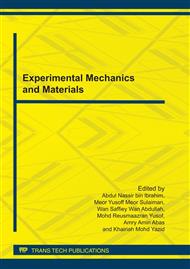p.179
p.185
p.191
p.197
p.204
p.210
p.216
p.224
p.230
Study on Tungsten Oxide (WO3) Nanostructures Formation via Seeded Growth Hydrothermal Reaction
Abstract:
This work describes the formation of WO3 nanostructures via seeded growth hydrothermal reaction. WO3 seed formation was first studied using thermal oxidation of W substrate from 300-500°C for 30 minutes. The optimum seeded substrates were then subjected to hydrothermal reaction at 80°C by varying precursor concentration and pH of the solution. Optimum oxidation temperature to produce WO3 seeds was at 400°C for 30 minutes. Below 400°C, no seed was formed while above that temperature the seeds became too compact and less uniform. The optimum hydrothermal reaction parameters were obtained after 24 hrs reaction time, concentration ratio of sodium tungstate dehydrate to cetyltrimethylammonium bromide (CTAB) of 6:1 and at pH 2. By lowering the pH and increasing the precursor concentration, the growth of WO3 nanostructures was enhanced. X-ray diffraction analysis showed that WO3 nanostructures formed were of hexagonal structure.
Info:
Periodical:
Pages:
204-209
Citation:
Online since:
July 2011
Keywords:
Price:
Сopyright:
© 2011 Trans Tech Publications Ltd. All Rights Reserved
Share:
Citation:


